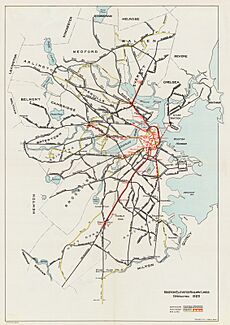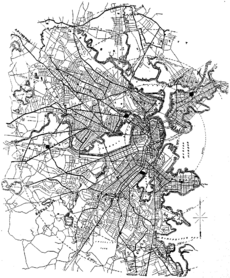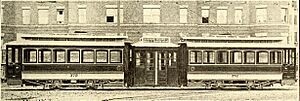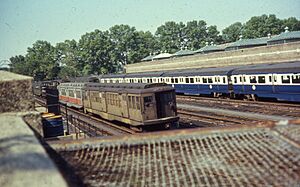Boston Elevated Railway facts for kids
The Boston Elevated Railway (BERy) was a company that ran streetcars and rapid transit trains. These trains traveled on, above, and under the streets of Boston, Massachusetts and nearby towns. It started in 1894.
BERy later took over the West End Street Railway. This made it the main public transport provider for the city. Today, its modern version is the Massachusetts Bay Transportation Authority (MBTA). The MBTA still uses some of the tracks and tunnels built by BERy and its older companies.
Contents
History of Boston's Public Transport


The West End Street Railway began in 1887. It first planned to build a short electric trolley line to Brookline. By 1888, it owned many horse-drawn streetcar lines. It had 7,816 horses and 1,480 rail vehicles.
The company decided to switch to electric power. They tested different systems. Finally, they chose to use overhead wires for their electric trolleys. This new electric system was recognized as an important achievement in electrical engineering in 2004.
The first electric trolley line opened in 1889. It ran between Union Square in Allston and Park Square downtown. The Green Line A branch later followed a similar path. The last horse-drawn car line closed around 1900. It was on Marlborough Street and was never electrified.
In the late 1800s, electric power was new. There was no large power grid like today. So, the railway company built its own power stations. By 1897, they had stations in many parts of Boston and nearby towns. By 1904, the system had enough power for 421 miles (677 km) of track. It ran over 1,550 streetcars and 174 elevated cars.
On November 7, 1916, a Boston Elevated Railway streetcar had a serious accident. It went through the warning gates of the open Summer Street drawbridge. The car plunged into the Fort Point Channel.
The first bus route started in 1922. It ran between Union Square in Allston and Faneuil Street. This route later became the 64 bus.
Elevated Trains and Mergers
In 1890, the West End Railway could build elevated railways (trains on tracks above the street). But they did not do it. So, a new company, the Boston Elevated Railway (BERy), was formed in 1894 to build them.
The first elevated track opened in 1901. It ran between Sullivan Square and Dudley Square. In 1897, BERy leased the West End's lines. The two companies officially joined in 1922. The elevated train network grew to have six end points. Trains were set up so passengers could reach any destination without changing lines.
How They Got Power
It was hard to bring coal to the power stations by land. Also, the early electric system could not send power very far. So, in 1911, a large power station was built in South Boston. This station made a special type of electricity that could travel long distances.
This power was sent to smaller stations called substations. These substations would change the electricity so trains could use it. The system was fully converted by 1931, with 14 substations. This main power station ran until 1981. By then, the MBTA could buy electricity from local power companies.
Changes to Bus and Trolleybus Routes
The first trackless trolley (a bus powered by overhead electric lines) opened on April 11, 1936. This was route 77 (later 69). It ran from Harvard to Lechmere.
Trackless trolley service to these routes ended in March 2022. They were replaced with temporary diesel buses. These will be replaced with battery electric buses in 2024.
How They Operated
The rapid transit lines run by BERy are now the Red, Blue, and Orange Lines. The only streetcars left are the different parts of the Green Line and the Ashmont–Mattapan High Speed Line. Most other streetcar lines were changed to bus routes.
The Boston Elevated Railway served many cities and towns, including:
- Arlington
- Belmont
- Boston and its merged towns
- Brookline
- Cambridge
- Chelsea
- Everett
- Malden
- Medford
- Newton (only for travel between Boston and Watertown)
- Revere
- Somerville
- Stoneham (only the southern part)
- Watertown
Also, streetcars from other companies in nearby towns used BERy's tracks. In 1947, the Metropolitan Transit Authority took over BERy's operations. This is now the MBTA.






